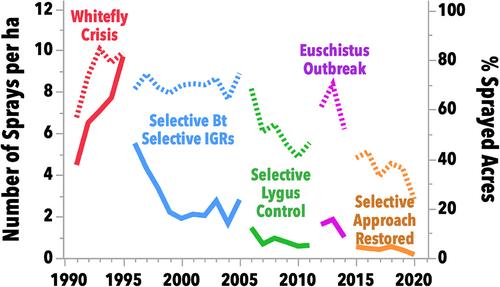当前位置:
X-MOL 学术
›
Pest Manag. Sci.
›
论文详情
Our official English website, www.x-mol.net, welcomes your feedback! (Note: you will need to create a separate account there.)
Theory versus practice: are insecticide mixtures in Arizona cotton used for resistance management?†
Pest Management Science ( IF 3.8 ) Pub Date : 2024-06-26 , DOI: 10.1002/ps.8241 Peter C Ellsworth 1 , Alfred Fournier 1
Pest Management Science ( IF 3.8 ) Pub Date : 2024-06-26 , DOI: 10.1002/ps.8241 Peter C Ellsworth 1 , Alfred Fournier 1
Affiliation

|
BACKGROUNDResistance management in pesticide use is critical, yet grower practices, especially pesticide mixing motivations, diverge from theoretical frameworks. This study analyzes 30 years of Arizona cotton growers’ practices and pest manager insights to understand mixing trends.RESULTSGrowers predominantly mix pesticides for spectrum or efficacy, not resistance management. This highlights a gap between theory and practice, emphasizing the complexity of real‐world dynamics. A shift over time towards selective insecticides and integrated pest management (IPM), supported by extension education, has reduced reliance on broad‐spectrum insecticides and increased opportunities to conserve the natural enemies of key pests. This reduced the frequency of insecticide use, a mutual goal of both IPM and resistance management. The availability and adoption of selective products with diverse modes of action, along with the resulting increases in biological control and refuges, likely has delayed or prevented resistances without emphasis on using mixtures specifically for resistance management. In a disrupted system exclusively dependent on broad‐spectrum insecticides (1991–1995), 75% ± 5% of cotton area was sprayed with mixtures of these materials. With the availability of selective insecticides, few broad‐spectrum products are used today and mixtures of insecticides are sprayed on only 36% ± 3% of the cotton area (2015–2020).CONCLUSIONAlthough mixing has theoretical relevance, it is diminishing in stable systems with diverse modes of action and adherence to moderation principles. Arizona cotton guidance prioritizes multi‐crop refuges over mixtures for resistance management. Integrated research and education, targeting professional pest managers, are pivotal in advancing resistance management without mixtures specifically designed to prevent or mitigate resistance. © 2024 Society of Chemical Industry.
中文翻译:

理论与实践:亚利桑那州棉花中的杀虫剂混合物是否用于抗性管理?†
背景农药使用中的抗性管理至关重要,但种植者的实践,尤其是农药混合动机,与理论框架存在分歧。这项研究分析了亚利桑那州棉花种植者 30 年来的实践和害虫管理者的见解,以了解混合趋势。结果 种植者主要为了广谱或功效而混合农药,而不是抗性管理。这凸显了理论与实践之间的差距,强调了现实世界动态的复杂性。随着时间的推移,在推广教育的支持下,向选择性杀虫剂和害虫综合防治(IPM)的转变减少了对广谱杀虫剂的依赖,并增加了保护主要害虫天敌的机会。这减少了杀虫剂的使用频率,这是病虫害综合治理和抗性管理的共同目标。具有不同作用模式的选择性产品的可用性和采用,以及由此产生的生物控制和庇护所的增加,可能延迟或预防了抗性,而不强调使用专门用于抗性管理的混合物。在一个完全依赖广谱杀虫剂的被破坏的系统中(1991-1995),75%±5%的棉花面积被喷洒了这些材料的混合物。随着选择性杀虫剂的出现,如今很少使用广谱产品,并且仅在 36% ± 3% 的棉花面积上喷洒杀虫剂混合物(2015-2020 年)。 结论 尽管混合具有理论上的相关性,但在稳定的系统中混合杀虫剂正在减少采取多种行动方式并坚持适度原则。亚利桑那州棉花指南优先考虑多种作物避难所,而不是混合作物以进行抗性管理。 针对专业害虫管理人员的综合研究和教育对于推进抗性管理至关重要,而无需专门设计用于预防或减轻抗性的混合物。 © 2024 化学工业协会。
更新日期:2024-06-26
中文翻译:

理论与实践:亚利桑那州棉花中的杀虫剂混合物是否用于抗性管理?†
背景农药使用中的抗性管理至关重要,但种植者的实践,尤其是农药混合动机,与理论框架存在分歧。这项研究分析了亚利桑那州棉花种植者 30 年来的实践和害虫管理者的见解,以了解混合趋势。结果 种植者主要为了广谱或功效而混合农药,而不是抗性管理。这凸显了理论与实践之间的差距,强调了现实世界动态的复杂性。随着时间的推移,在推广教育的支持下,向选择性杀虫剂和害虫综合防治(IPM)的转变减少了对广谱杀虫剂的依赖,并增加了保护主要害虫天敌的机会。这减少了杀虫剂的使用频率,这是病虫害综合治理和抗性管理的共同目标。具有不同作用模式的选择性产品的可用性和采用,以及由此产生的生物控制和庇护所的增加,可能延迟或预防了抗性,而不强调使用专门用于抗性管理的混合物。在一个完全依赖广谱杀虫剂的被破坏的系统中(1991-1995),75%±5%的棉花面积被喷洒了这些材料的混合物。随着选择性杀虫剂的出现,如今很少使用广谱产品,并且仅在 36% ± 3% 的棉花面积上喷洒杀虫剂混合物(2015-2020 年)。 结论 尽管混合具有理论上的相关性,但在稳定的系统中混合杀虫剂正在减少采取多种行动方式并坚持适度原则。亚利桑那州棉花指南优先考虑多种作物避难所,而不是混合作物以进行抗性管理。 针对专业害虫管理人员的综合研究和教育对于推进抗性管理至关重要,而无需专门设计用于预防或减轻抗性的混合物。 © 2024 化学工业协会。






































 京公网安备 11010802027423号
京公网安备 11010802027423号